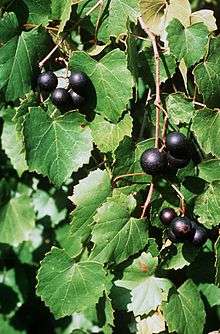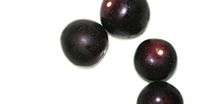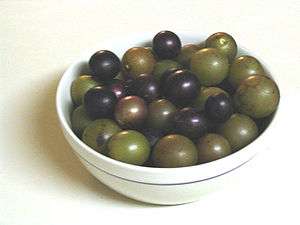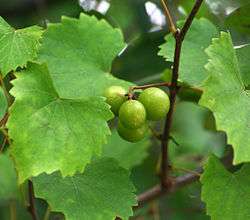Vitis rotundifolia
Vitis rotundifolia, or muscadine,[1] is a grapevine species native to the southeastern and south-central United States.[2] The growth range extends from Florida to New Jersey coast, and west to eastern Texas and Oklahoma.[3] It has been extensively cultivated since the 16th century.[4] The plants are well-adapted to their native warm and humid climate; they need fewer chilling hours than better known varieties, and thrive in summer heat.
| Muscadine | |
|---|---|
 | |
| Scientific classification | |
| Kingdom: | |
| (unranked): | |
| (unranked): | |
| (unranked): | |
| Order: | |
| Family: | |
| Genus: | |
| Subgenus: | Muscadinia |
| Species: | V. rotundifolia |
| Binomial name | |
| Vitis rotundifolia Michx. | |
Muscadine berries may be bronze or dark purple or black when ripe.[5] Wild varieties may stay green through maturity. Muscadines have thick, tough skin, making eating raw fruit similar to eating a plum.[6] Muscadines are typically used in making artisan wines, juice, and jelly. They are rich sources of polyphenols.[7]
In a natural setting, muscadines provide wildlife habitat as shelter, browse, and food for many birds and animals.[2] It is a larval host for the Nessus Sphinx Moth (Amphion floridensis) and the Mournful Sphinx Moth (Enyo lugubris).[8]
Taxonomy and pathology
Although in the same genus Vitis with the other grapevine species, muscadines belong to a separate subgenus, Muscadinia (the other grapevine species belong to subgenus Euvitis), and some have suggested giving it standing as a genus of its own. Some taxonomists have also suggested splitting two additional species off from Vitis rotundifolia, Vitis munsoniana and Vitis popenoei. All have 40 chromosomes, rather than 38, are generally not cross-compatible with Euvitis species, and most hybrids between the subgenera are sterile. A few are moderately fertile, and have been used in breeding. A commercially available Euvitis x Muscadinia hybrid is the Southern Home cultivar.[9]
Although muscadines are hearty grapes with tough skin that protects them from many plant diseases, these grapes appear to be susceptible to parasitic nematodes.[10]
Cultivars

There are about 152[11] muscadine cultivars grown in the Southern states.[12] These include bronze, black and red varieties and consist of common grapes and patented grapes.[13]
Unlike most cultivated grapevines, many muscadine cultivars are pistillate, requiring a pollenizer to set fruit. A few, such as 'Carlos' and 'Noble', are perfect-flowered, produce fruit with their own pollen, and may also pollinate pistillate cultivars.[12]
Muscadine grape cultivars may have low or inconsistent yields, small berries, flavor and thick skin unsuitable to consumer acceptance, and disease susceptibility.[2] Cultivars tend to be developed either for a limited fresh market or for winemaking.[2] For consumer acceptance, fresh market grapes need to be large, sweet, and with relatively thin skin, whereas those for wine, juice or jelly need high yields of high-sugar, color-stable berries.[2]
Fresh-market cultivars include Black Beauty, Carlos, Cowart, Flowers, Fry, Granny Val, Ison, James, Jumbo, Magnolia, Memory (first found on T.S. Memory's farm in 1868 in Whiteville, NC), Mish, Nesbitt, Noble, Scuppernong, Summit, Supreme, and Thomas.[2][13][14] Produced by the University of Florida, the cultivar, 'Southern Home', contains both muscadine and subgenus Vitis in its background.[2]
Crops can be started in 3–5 years. Commercial yields of 20–45 tonnes per hectare (8–18 tons per acre) are possible. Muscadines grow best in fertile sandy loam and alluvial soils. They grow wild in well-drained bottom lands that are not subject to extended drought or waterlogging. They are also resistant to pests and diseases, including Pierce's disease, which can destroy other grape species. Muscadine is one of the grape species most resistant to Phylloxera, an insect that can kill roots of grapevines.[15]
Appellations

Appellations producing Muscadine wines:[16]
- America (Country Appellation)
- Alabama (State Appellation)
- Arkansas (State Appellation)
- Florida (State Appellation)
- Georgia (State Appellation)
- Louisiana (State Appellation)
- Mississippi (State Appellation)
- North Carolina (State Appellation)
- South Carolina (State Appellation)
- Tennessee (State Appellation)
- Texas (State Appellation)
- Virginia (State Appellation)
Nutrients
100 grams of muscadine grapes contain the following nutrients according to the USDA:[15]
- Energy: 57 kilocalories
- Fats: 0.47 g
- Carbohydrates: 13.93 g
- Dietary Fiber: 3.9 g
- Protein: 0.81 g
- Calcium: 37 mg
- Phosphorus: 24 mg
- Potassium: 203 mg
- Sodium: 1 mg
- Vitamin C (total ascorbic acid): 6.5 mg
- Riboflavin: 1.5 mg
Consumer research
Consumer research indicates that the thick skins and variable in-season quality of fresh muscadine grapes are significant deterrents to retail acceptance.[6][13]
Resveratrol and other polyphenols

As muscadine grapes are notable for their highly pigmented, thick skins in which the content of polyphenols is known to be high,[7] there is active research interest to define these phytochemicals. One report indicated that muscadine grapes contained high concentrations of resveratrol,[17] but subsequent studies have found no or little resveratrol in muscadine grapes.[18]
Other muscadine polyphenols include:[7][19][20]
- anthocyanins such as delphinidin and petunidin
- tannins
- quercetin
- flavan-3-ols (catechins, particularly in seeds)
- gallic acid
- ellagic acid (particularly in skin)
- ellagic acid glycosides
- ellagitannins
- myricetin (particularly in leaves)
- kaempferol
The rank order of total phenolic content among muscadine components was found to be seeds higher than skins higher than leaves higher than pulp.[7]
References
- "Vitis rotundifolia". Natural Resources Conservation Service PLANTS Database. USDA. Retrieved 6 August 2015.
- Peter C. Andersen, Timothy E. Crocker, Jacque Breman (2018). "The muscadine grape". Institute of Food and Agricultural Sciences, University of Florida. Retrieved 27 September 2019.CS1 maint: uses authors parameter (link)
- Biota of North America Program 2014 county distribution map
- "Profile for Vitis rotundifolia (muscadine)". PLANTS Database. USDA, NRCS. Retrieved October 18, 2011.
- Boning, Charles (2006). Florida's Best Fruiting Plants: Native and Exotic Trees, Shrubs, and Vines. Sarasota, Florida: Pineapple Press, Inc. p. 155. ISBN 1561643726.
- Brown, K; Sims, C; Odabasi, A; Bartoshuk, L; Conner, P; Gray, D (2016). "Consumer Acceptability of Fresh-Market Muscadine Grapes". Journal of Food Science. 81 (11): S2808–S2816. doi:10.1111/1750-3841.13522. PMID 27741360.
- Pastrana-Bonilla E, Akoh CC, Sellappan S, Krewer G (August 2003). "Phenolic content and antioxidant capacity of muscadine grapes". Journal of Agricultural and Food Chemistry. 51 (18): 5497–503. doi:10.1021/jf030113c. PMID 12926904.
- "Muscadine, Muscadine grape". Natives for your Neighborhood.
- J.A. Mortensen, J.W. Harris, D.L. Hopkins, P.C. Andersen (1994). "'Southern Home': An InterspecificHybrid Grape with Ornamental Value" (PDF). HortScience. 29 (11): 1371–1372. doi:10.21273/HORTSCI.29.11.1371.CS1 maint: uses authors parameter (link)
- Jagdale, Ganpati; Severns, Paul; Brannen, Phillip; Cline, William (2019). "Occurrence and distribution of plant-parasitic nematodes on muscadine grapes in Georgia and North Carolina". Plant Health Progress. 20 (3): 194–199. doi:10.1094/PHP-06-19-0042-S.
- "Muscadine: Vitis International Variety Catalog". Julius Kühn-Institut - Federal Research Centre for Cultivated Plants. Retrieved 7 February 2018.
- "Muscadine Grape Breeding Program: General Information". Muscadine Grape Breeding Program: General Information. University of Georgia College of Agricultural and Environmental Sciences. Archived from the original on 7 September 2015. Retrieved 11 October 2015.
- Xu, C; Yagiz, Y; Zhao, L; Simonne, A; Lu, J; Marshall, M. R. (2017). "Fruit quality, nutraceutical and antimicrobial properties of 58 muscadine grape varieties (Vitis rotundifolia Michx.) grown in United States". Food Chemistry. 215: 149–56. doi:10.1016/j.foodchem.2016.07.163. PMID 27542461.
- Growing Muscadine Grapes in Oklahoma
- "America's First Grape – The Muscadine". United States Department of Agriculture. November 1997.
- "Appellations Growing Muscadine Grapes". Appellation America. Retrieved 2007-12-01.
- Ector BJ, Magee JB, Hegwood CP, Coign MJ. (1996). "Resveratrol Concentration in Muscadine Berries, Juice, Pomace, Purees, Seeds, and Wines". American Journal of Enology and Viticulture. 47: 57–62.CS1 maint: uses authors parameter (link)
- Pastrana-Bonilla, E; Akoh, CC; Sellappan, S; Krewer, G (2003). "Phenolic content and antioxidant capacity of muscadine grapes". J Agric Food Chem. 51 (18): 5497–503. doi:10.1021/jf030113c. PMID 12926904.
Contrary to previous results, ellagic acid and not resveratrol was the major phenolic in muscadine grapes.
- Talcott ST, Lee JH (May 2002). "Ellagic acid and flavonoid antioxidant content of muscadine wine and juice". Journal of Agricultural and Food Chemistry. 50 (11): 3186–92. doi:10.1021/jf011500u. PMID 12009984.
- Lee JH, Johnson JV, Talcott ST (July 2005). "Identification of ellagic acid conjugates and other polyphenolics in muscadine grapes by HPLC-ESI-MS". Journal of Agricultural and Food Chemistry. 53 (15): 6003–10. doi:10.1021/jf050468r. PMID 16028988.
External links
| Wikimedia Commons has media related to Vitis rotundifolia. |
- The Muscadine Experience: Adding Value to Enhance Profits 2004 – 80 page technical resource for growers and processors, University of Arkansas.